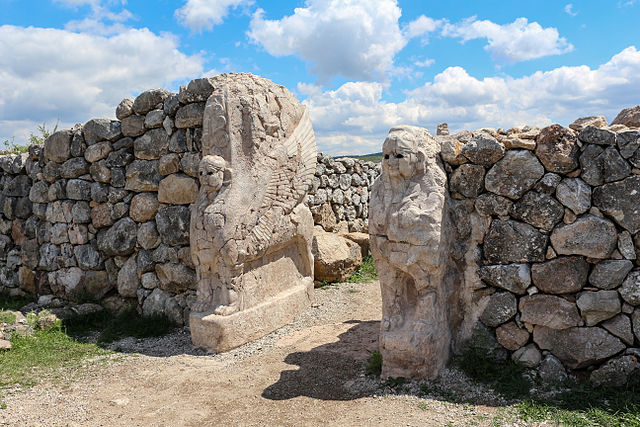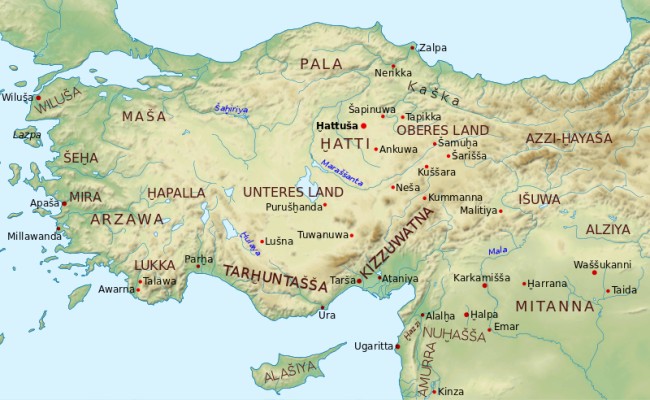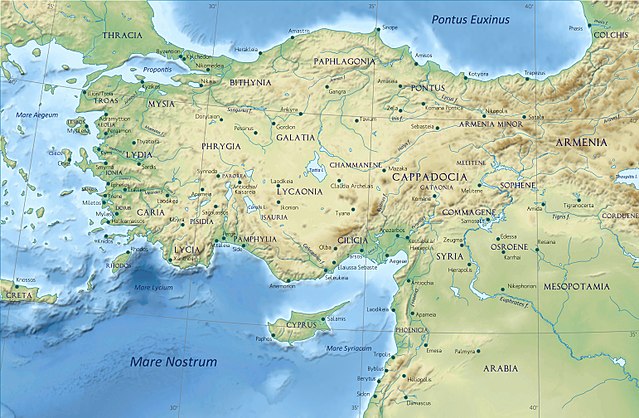
| ANATOLIAN PEOPLES Anatolians were Indo-European peoples of the Near East identified by their use of the Anatolian languages. These peoples were among the oldest Indo-European ethnolinguistic groups, one of the most archaic, because Anatolians were the first or among the first branches of Indo-European peoples to separate from the initial Proto-Indo-European community that gave origin to the individual Indo-European peoples.
History
:
Indo-European migrations as described in The Horse, the Wheel, and Language by David W. Anthony Together with the Proto-Tocharians, who migrated eastward, the Anatolian peoples constituted the first known waves of Indo-European emigrants out of the Eurasian steppe. It is likely that they reached the Near East from the north, via the Balkans or the Caucasus, in the 3rd millennium BC. This movement has yet to be documented archaeologically. Although they had wagons, they probably emigrated before Indo-Europeans had learned to use chariots for war. Comparison of Hittite agricultural terms with those of other Indo-European subgroups indicate that the Anatolian peoples seceded from the other Indo-Europeans before the establishment of a common agricultural nomenclature, which suggests that they entered the Near East as a cohesive people through a common route.
The Anatolian peoples were intruders in an area in which the local population had already founded cities, established literate bureaucracies and established kingdoms and palace cults. Once they entered the region, the cultures of the local populations, in particular the Hattians, significantly influenced them linguistically, politically and religiously. Christopher I. Beckwith suggests that the Anatolian peoples initially gained a foothold in Anatolia after being hired by the Hattians to fight other invading Indo-European groups.
Bronze Age :
Sphinx Gate entrance at Hattusa, capital of the Hittite Empire The earliest linguistic and historical attestation of the Anatolian peoples are names mentioned in Assyrian mercantile texts from 19th Century BC at Kanesh. Kanesh was at the time the center of a network of Assyrian merchants overseeing trade between Assyria and the warring states of Anatolia. This certainly increased the power of the Anatolian peoples who inhabited the city.
The Hittites are by far the best known of the Anatolian peoples. Originally referring to themselves as the Neshites after their capital at Kanesh, which they had at one point captured from the Hatti, the Hittites then seized the Hattic capital of Hattusa. The Hittite language thereafter gradually supplanted Hattic as the predominant language in Anatolia. Uniting several independent Hattic kingdoms in Anatolia the Hittites began establishing a Middle Eastern empire in the 17th-century BC. They sacked Babylon, seized Assyrian cities and fought the Egyptian Empire to a standstill at the Battle of Kadesh, the greatest chariot battle of the ancient world. Their empire disappeared with the Late Bronze Age collapse in the 12th-century BC. As Hittite was a language of the elite, the language disappeared with the empire.
Another Anatolian group were the Luwians, who migrated to south-west Anatolia in the early Bronze Age. Unlike Hittite, the Luwian language does not contain loanwords from Hattic, indicating that it was initially spoken in western Anatolia. They Luwians inhabited a large area and their language was spoken after the collapse of the Hittite Empire.
Relief of Yariri and Kamani, 8th-century BC Luwian rulers of Carchemish, a Neo-Hittite State (despite the name, Neo-Hittites were overwhelmingly Luwians and not Hittites) The least known Anatolian group were the Palaic peoples, who inhabited the region of Pala in northern Anatolia. This area had probably also previously been inhabited by the Hatti. It is likely that Palaic peoples disappeared with the invasion of the Kaskians in the 15th-century BC.
Iron
Age :
Culture
:
List :
Late Bronze Age regions of Anatolia/Asia Minor (circa 1200 BC) with main settlements
Anatolia/Asia Minor in the Greco-Roman period. The classical regions and their main settlements (circa 200 BC) Anatolian (Indo-European) peoples :
• Hittites
• Luwians
• Palaic peoples
Possible Anatolian (Indo-European) peoples :
• Mysians? (possibly they were more related to the Phrygians, a non Anatolian Indo-European people, and therefore they were possibly not an Anatolian Indo-European people, Mysia was also known as Phrygia Hellespontica, however they probably had a mixing with an Anatolian people closer to the Lydians that would explain contradictory statements by ancient authors)
Source :
https://en.wikipedia.org/ |
,_The_Horse,_The_Wheel_and_Language.jpg)



